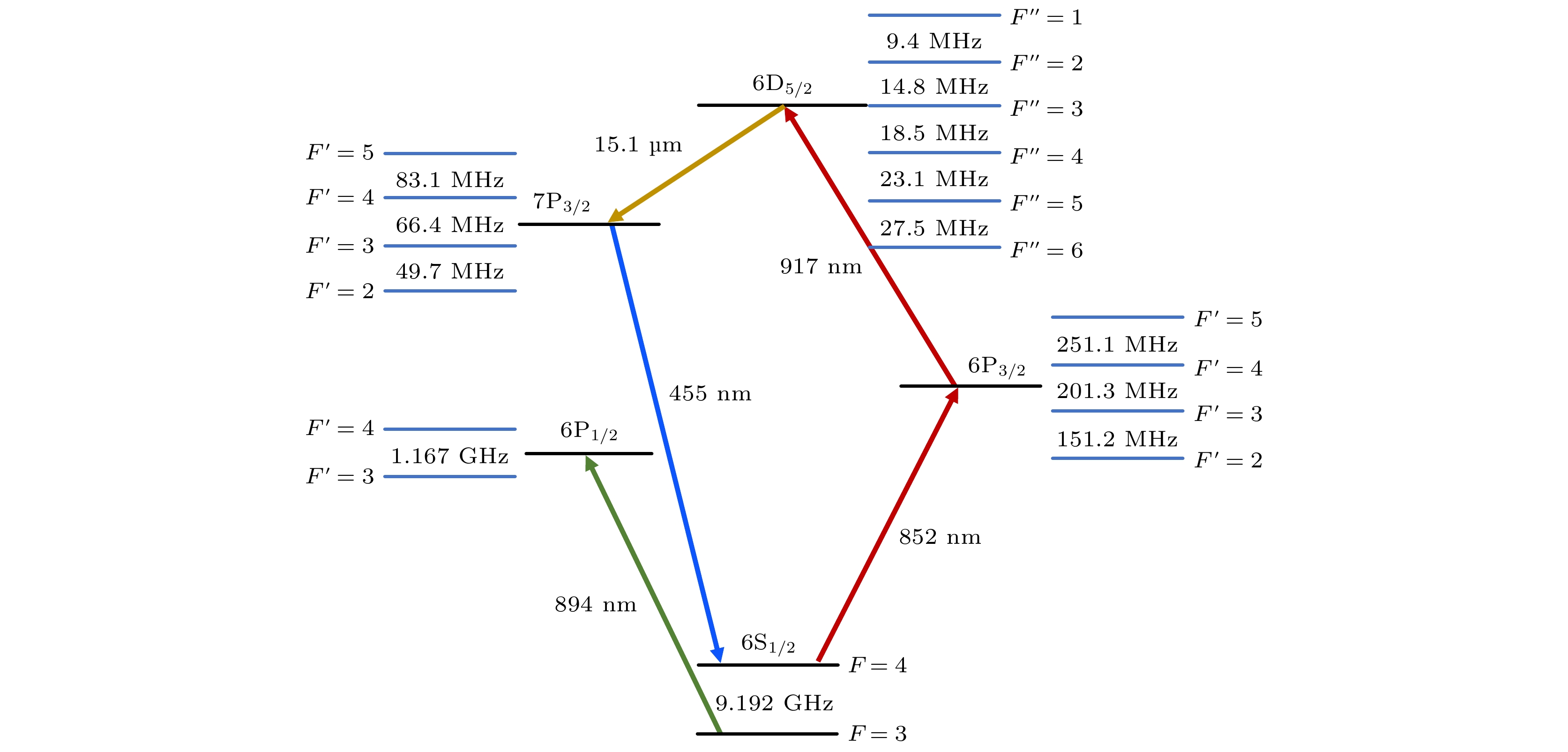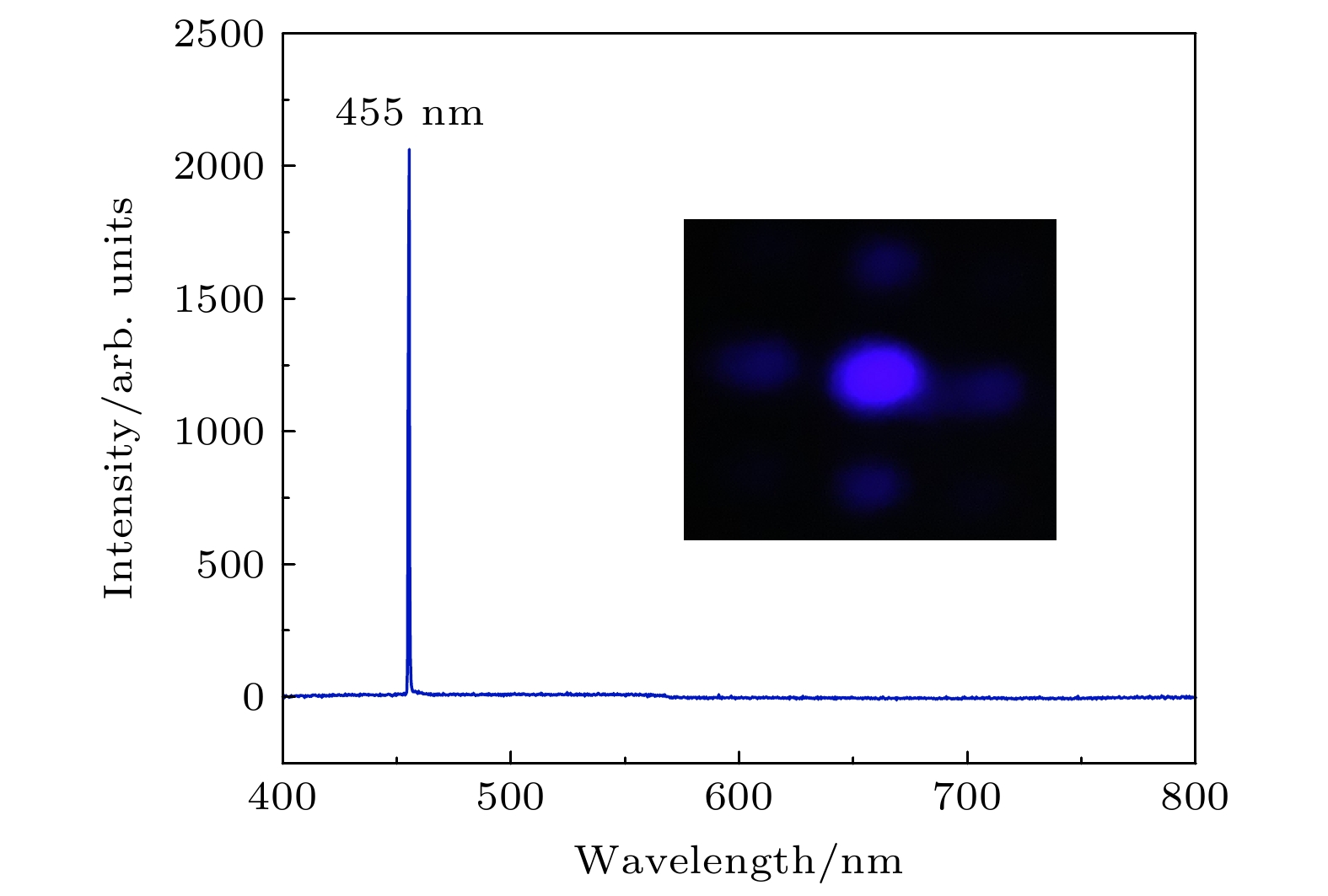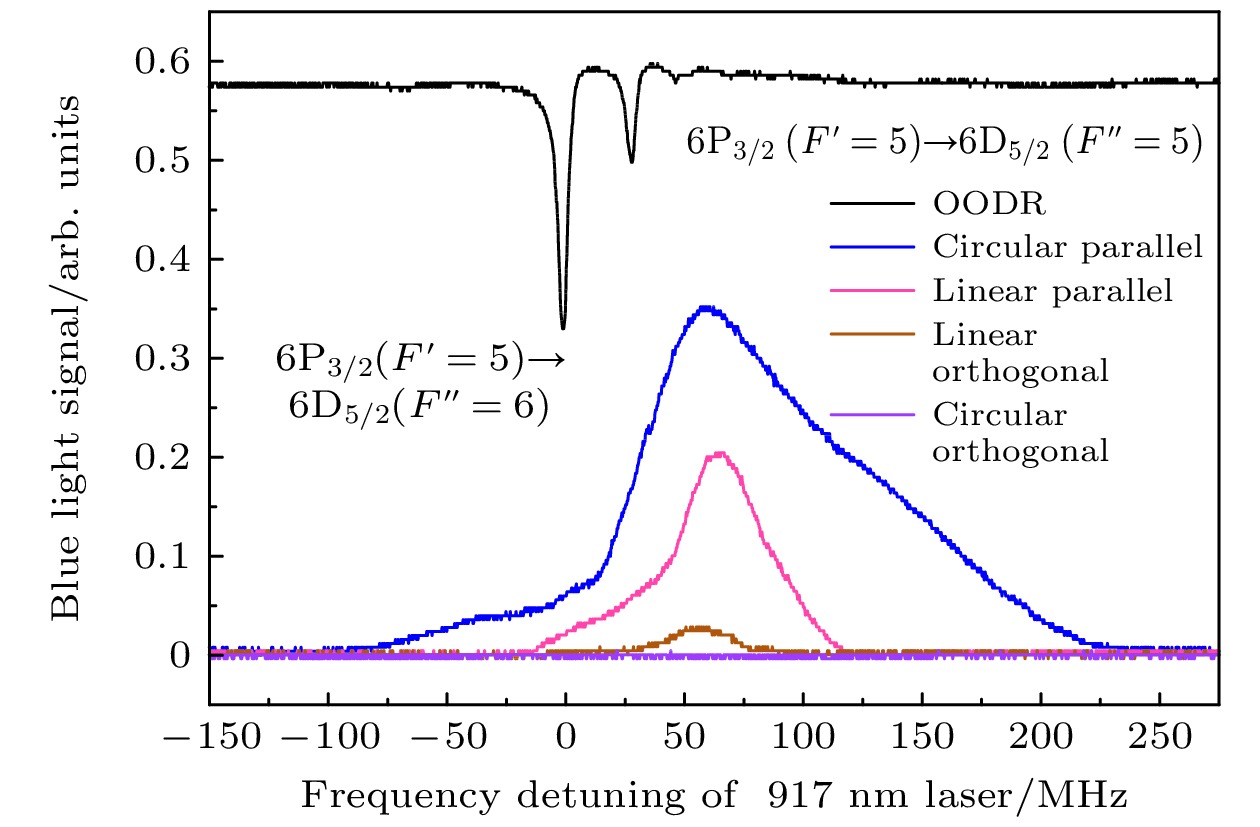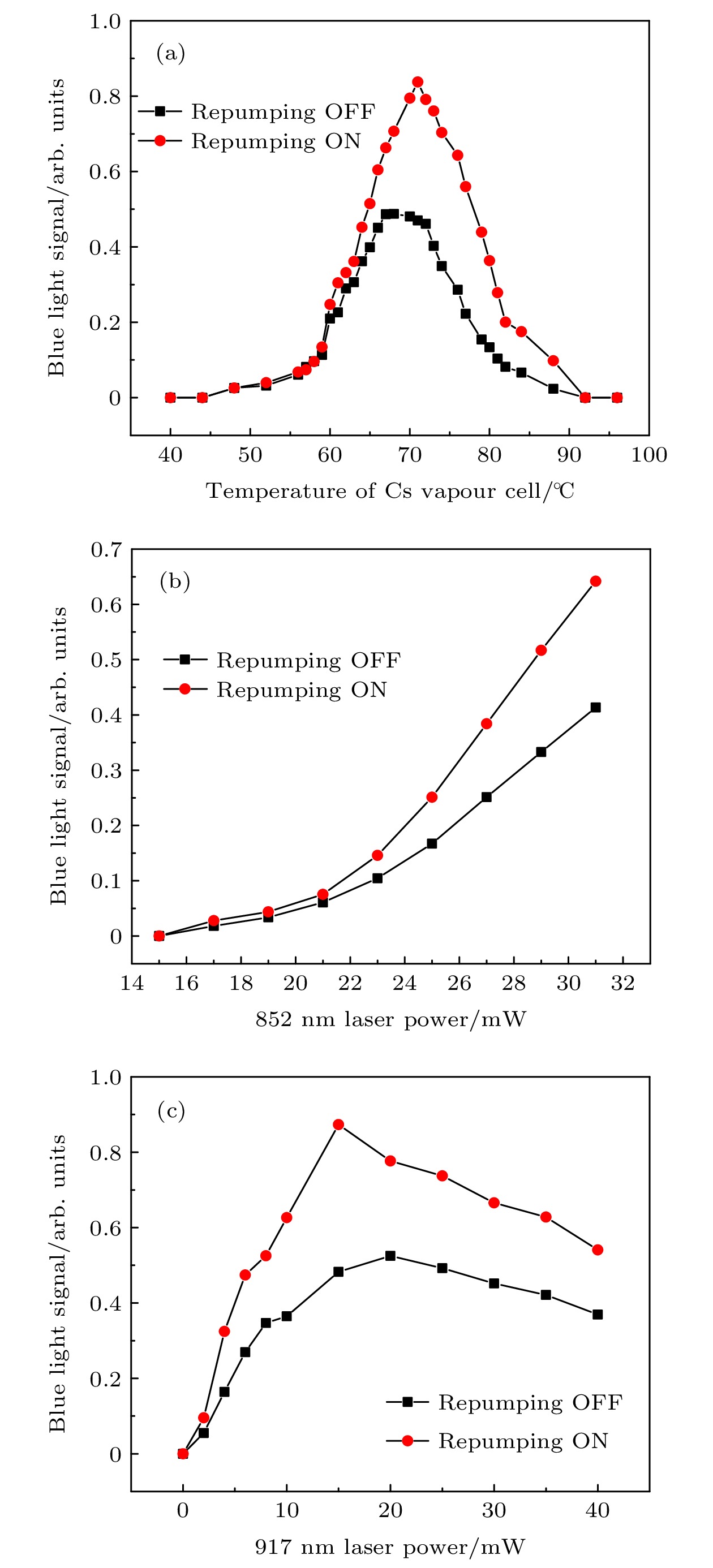-
基于铯原子菱形能级6S1/2 (F = 4)→6P3/2 (F' = 5)→6D5/2 (F'' = 6)→7P3/2 (F' = 5)→6S1/2 (F = 4)系统, 在波长为852 nm (6S1/2→6P3/2)和917 nm (6P3/2→6D5/2)两红外抽运激光共同激励下, 通过四波混频过程频率上转换产生了波长为455 nm (7P3/2→6S1/2)的相干、准直蓝光. 实验上详细研究了抽运光偏振组合、功率、铯原子气室温度对蓝光强度的影响. 在此基础上, 通过增加了一束波长为894 nm (6S1/2 (F = 3)→6P1/2 (F' = 3, 4))的反抽运激光, 将更多的原子抽运回基态6S1/2 (F = 4)超精细能级, 显著增加了相干蓝光功率的输出, 在水下自由空间光通信领域等有一定的应用价值.We demonstrate the generation of coherent and collimated blue light (CBL) based on cesium (Cs) 6S1/2(F = 4)→6P3/2(F' = 5)→6D5/2(F'' = 6)→7P3/2(F' = 5)→6S1/2(F = 4) diamond-type atomic system in a heated vapor cell. Two infrared pumping lasers with wavelengths at 852 nm (6S1/2→6P3/2) and 917 nm (6P3/2→6D5/2), provide step-wise excitation to the 6D5/2 excited state, and induce strong two-photon coherence between the 6S1/2 state and 6D5/2 state. The atoms undergo a double cascade accompanied with the amplified spontaneous emission at 15.1 μm via the 7P3/2 intermediate excited state, and produce a beam of 455 nm (7P3/2→6S1/2) CBL with highly spatiotemporal coherence through a parametric four-wave mixing process. We investigate the influence of experimental parameters such as polarization combination of the two pumping lasers, and their power, and the temperature of Cs vapor cell on the CBL. Especially, we add a beam of 894 nm laser operating at the 6S1/2(F = 3) →6P1/2 transition as repumping laser, which can pump atoms back to the 6S1/2(F = 4) state from the 6S1/2(F = 3) state, thus significantly improving the power of CBL. This technique of the CBL enhancement via optical pumping is also useful for the other alkali metal atoms.
-
Keywords:
- four-wave mixing /
- nonlinear optics /
- frequency conversion /
- optical pumping
[1] Mohapatra A K, Jackson T R, Adams C S 2007 Phys. Rev. Lett. 98 113003
 Google Scholar
Google Scholar
[2] Yang B D, Gao J, Zhang T C, Wang J M 2011 Phys. Rev. A 83 013818
 Google Scholar
Google Scholar
[3] Vanier J 2005 Appl. Phys. B 81 421
 Google Scholar
Google Scholar
[4] Akulshin A M, Perrella C, Truong G W, McLean R J, Luiten A 2012 J. Phys. B: At. Mol. Opt. Phys. 45 245503
 Google Scholar
Google Scholar
[5] 冯啸天, 袁春华, 陈丽清, 陈洁菲, 张可烨, 张卫平 2018 物理学报 67 164204
 Google Scholar
Google Scholar
Feng X T, Yuan C H, Chen L Q, Chen J F, Zhang K Y, Zhang W P 2018 Acta Phys. Sin. 67 164204
 Google Scholar
Google Scholar
[6] Scully M O, Fleischhauer M 1994 Science 263 337
 Google Scholar
Google Scholar
[7] Akulshin A M, Bustos F P, Budker D 2018 Opt. Lett. 43 5279
 Google Scholar
Google Scholar
[8] Lam M, Pal S B, Vogt T, Gross C, Kiffner M, Li W H 2019 Opt. Lett. 44 2931
 Google Scholar
Google Scholar
[9] Gai B D, Hu S, Chu J Z, Wang P Y, Cai X L, Guo J W 2021 OSA Continuum. 4 2410
 Google Scholar
Google Scholar
[10] Zibrov A S, Lukin M D, Hollberg L, Scully M O 2002 2002 Phys. Rev. A 65 051801(R
 Google Scholar
Google Scholar
[11] Meijer T, White J D, Smeets B, Jeppesen M, Scholten R E 2006 Opt. Lett. 31 1002
 Google Scholar
Google Scholar
[12] Akulshin A M, McLean R J, Sidorov A I, Hannaford P 2009 Opt. Express 17 22861
 Google Scholar
Google Scholar
[13] Kienlen M B, Holte N T, Dassonville H A, et al. 2013 Am. J. Phys. 81 442
 Google Scholar
Google Scholar
[14] Akulshin A M, Budker D, McLean R J 2014 Opt. Lett. 39 845
 Google Scholar
Google Scholar
[15] Sebbag Y, Barash Y, Levy U 2019 Opt. Lett. 44 971
 Google Scholar
Google Scholar
[16] Vernier A, Franke-Arnold S, Riis E, Arnold A S 2010 Opt. Express 18 17020
 Google Scholar
Google Scholar
[17] Akulshin A M, Orel A A, McLean R J 2012 J. Phys. B: At. Mol. Opt. Phys. 45 015401
 Google Scholar
Google Scholar
[18] Cao R, Gai B D, Yang J, et al. 2015 Chin. Opt. Lett. 13 121903
 Google Scholar
Google Scholar
[19] Prajapati N, Akulshin A M, Novikova I 2018 J. Opt. Soc. Am. B 35 1133
 Google Scholar
Google Scholar
[20] Moreno M P, Almeida A A C, Vianna S S 2019 Phys. Rev. A 99 043410
 Google Scholar
Google Scholar
[21] Offer R F, Conway J W C, Riis E, Franke-Arnold S, Arnold A S 2016 Opt. Lett. 41 2177
 Google Scholar
Google Scholar
[22] Yuan J P, Liu H, Wang L R, Xiao L T, Jia S T 2021 Opt. Express 29 4858
 Google Scholar
Google Scholar
[23] Akulshin A M, Budker D, Mclean R J 2017 J. Opt. Soc. Am. B 34 1016
 Google Scholar
Google Scholar
[24] Schultz J T, Abend S, Döring D, Debs J E, Altin P A, White J D, Robins N P, Close J D 2009 Opt. Lett. 34 2321
 Google Scholar
Google Scholar
[25] Zhang Y Y, Wu J Z, He Y Y, Zhang Y, Hu Y D, Zhang J X, Zhu S Y 2020 Opt. Express 28 17723
 Google Scholar
Google Scholar
[26] Wu J Z, Xu Y H, Dong R G, Zhang J X 2021 Opt. Lett. 46 3119
 Google Scholar
Google Scholar
[27] Yang B D, Liang Q B, He J, Zhang T C, Wang J M 2010 Phys. Rev. A 81 043803
 Google Scholar
Google Scholar
[28] Yang B D, Zhang J F, Wang J M 2019 Chin. Opt. Lett. 17 093001
 Google Scholar
Google Scholar
-
图 2 反抽运光增强相干455 nm蓝光的实验装置示意图(PBS, 立方偏振棱镜; HWP, 半波片; QWP, 四分之一波片; DM, 双色镜; M, 平面反射镜; Cs cell, 铯原子气室; Filter, 蓝光滤色片; PD, 光电探测器; PMT, 光电倍增管; Spectrometer, 光纤光谱仪)
Fig. 2. Schematic of experimental setup for coherent 455 nm blue light enhancement via repumping laser (PBS, polarizing beam splitter; HWP, half wave plate; QWP, quarter wave plate; DM, dichroic mirror; M, mirror; Cs cell, cesium vapor cell; Filter, 455 nm blue filter; PD, photo diode; PMT, photomultiplier tube; Spectrometer, optical fiber spectrometer).
图 4 不同抽运光场偏振组合下, 相干455 nm蓝光信号随抽运光@917 nm频率失谐的变化. 抽运光@852 nm频率共振于6S1/2(F = 4)→6P3/2(F' = 5)跃迁线, 抽运光@917 nm频率在6P3/2→6D5/ 2跃迁线之间扫描. 最上方黑色曲线为6P3/2→6D5/ 2跃迁的OODR光谱, 其作为频率参考; 其他曲线为来自光电倍增管PMT的相干455 nm蓝光信号
Fig. 4. Profiles of the 455 nm coherent blue light at different combinations of the two pump lasers’ polarizations. The pump laser @852 nm is resonant on the 6S1/2(F = 4)→ 6P3/2(F' = 5) transition, while the pump laser @917 nm is scanned over the 6P3/2→6D5/2 transition. The upper curve represents the OODR spectrum between the 6P3/2→6D5/2 hyperfine transition as a frequency reference, and other curves are the 455 nm coherent blue light signals from the PMT.
图 5 归一化的相干455 nm蓝光增强信号随894 nm反抽运光频率失谐的变化. 两抽运光852 nm和917 nm频率共振于6S1/2(F = 4)→6P3/2(F' = 5)→6D5/2(F'' = 6)循环跃迁线, 894 nm反抽运光零失谐位置为6S1/2(F = 3)→6P1/2(F' = 4)超精细跃迁线. 图中上方黑色曲线为6S1/2(F = 3)→6P1/2跃迁的饱和吸收谱, 其作为频率参考
Fig. 5. Normalized coherent 455 nm blue light intensity as a function of frequency detuning of repumping laser @894 nm from the 6S1/2(F = 3)→6P1/2(F' = 4) transition. The 852 nm and 917 nm pump lasers are resonant on the 6S1/2(F = 4)→6P3/2(F' = 5)→6D5/2(F'' = 6) transitions, respectively. The upper curve represents the SAS signal between the 6S1/2(F = 3)→6P1/2 transition as a frequency reference.
图 6 (a) 894 nm反抽运光存在与否时, 相干455 nm蓝光强度的对比(抽运光@852 nm频率共振于6S1/2(F = 4)→6P3/2(F' = 5)跃迁线, 抽运光@917 nm频率在6P3/2→6D5/ 2跃迁线之间扫描); (b) 归一化的相干455 nm蓝光强度随894 nm反抽运光功率的变化
Fig. 6. (a) Comparison of coherent 455 nm blue light intensity versus the frequency detuning of pump laser @917 nm between the presence or absence of repuming laser @894 nm, when the pump laser @852 nm laser is resonant on the 6S1/2(F = 4)→6P3/2(F' = 5) transition; (b) normalized coherent 455 nm blue light intensity dependence of the power of repumping laser @894 nm.
图 7 反抽运光存在与否时, 相干455 nm蓝光强度随铯原子气室温度(a)、抽运光@852 nm功率 (b)、抽运光@917 nm功率(c)的变化. 抽运光@852 nm频率共振于6S1/2(F = 4)→6P3/2(F' = 5)超精细跃迁线, 抽运光@917 nm频率在6P3/2→6D5/2跃迁线之间扫描. 反抽运光@894 nm频率共振于6S1/2(F = 3)→6P1/2(F' = 4)超精细跃迁线
Fig. 7. Comparisons of coherent 455 nm blue light intensity versus the temperature of the Cs vapor cell (a), power of pump laser @852 nm (b), and power of pump laser @917 nm (c) between the presence or absence of 894 nm repumping laser: The pump laser @852 nm is resonant on the 6S1/2(F = 4)→6P3/2(F' = 5) transition, while the pump laser @917 nm is scanned over the 6P3/2→6D5/2 transition, and the repumping laser @894 nm is resonant on the 6S1/2(F = 3)→6P1/2(F' = 4) transition, respectively.
-
[1] Mohapatra A K, Jackson T R, Adams C S 2007 Phys. Rev. Lett. 98 113003
 Google Scholar
Google Scholar
[2] Yang B D, Gao J, Zhang T C, Wang J M 2011 Phys. Rev. A 83 013818
 Google Scholar
Google Scholar
[3] Vanier J 2005 Appl. Phys. B 81 421
 Google Scholar
Google Scholar
[4] Akulshin A M, Perrella C, Truong G W, McLean R J, Luiten A 2012 J. Phys. B: At. Mol. Opt. Phys. 45 245503
 Google Scholar
Google Scholar
[5] 冯啸天, 袁春华, 陈丽清, 陈洁菲, 张可烨, 张卫平 2018 物理学报 67 164204
 Google Scholar
Google Scholar
Feng X T, Yuan C H, Chen L Q, Chen J F, Zhang K Y, Zhang W P 2018 Acta Phys. Sin. 67 164204
 Google Scholar
Google Scholar
[6] Scully M O, Fleischhauer M 1994 Science 263 337
 Google Scholar
Google Scholar
[7] Akulshin A M, Bustos F P, Budker D 2018 Opt. Lett. 43 5279
 Google Scholar
Google Scholar
[8] Lam M, Pal S B, Vogt T, Gross C, Kiffner M, Li W H 2019 Opt. Lett. 44 2931
 Google Scholar
Google Scholar
[9] Gai B D, Hu S, Chu J Z, Wang P Y, Cai X L, Guo J W 2021 OSA Continuum. 4 2410
 Google Scholar
Google Scholar
[10] Zibrov A S, Lukin M D, Hollberg L, Scully M O 2002 2002 Phys. Rev. A 65 051801(R
 Google Scholar
Google Scholar
[11] Meijer T, White J D, Smeets B, Jeppesen M, Scholten R E 2006 Opt. Lett. 31 1002
 Google Scholar
Google Scholar
[12] Akulshin A M, McLean R J, Sidorov A I, Hannaford P 2009 Opt. Express 17 22861
 Google Scholar
Google Scholar
[13] Kienlen M B, Holte N T, Dassonville H A, et al. 2013 Am. J. Phys. 81 442
 Google Scholar
Google Scholar
[14] Akulshin A M, Budker D, McLean R J 2014 Opt. Lett. 39 845
 Google Scholar
Google Scholar
[15] Sebbag Y, Barash Y, Levy U 2019 Opt. Lett. 44 971
 Google Scholar
Google Scholar
[16] Vernier A, Franke-Arnold S, Riis E, Arnold A S 2010 Opt. Express 18 17020
 Google Scholar
Google Scholar
[17] Akulshin A M, Orel A A, McLean R J 2012 J. Phys. B: At. Mol. Opt. Phys. 45 015401
 Google Scholar
Google Scholar
[18] Cao R, Gai B D, Yang J, et al. 2015 Chin. Opt. Lett. 13 121903
 Google Scholar
Google Scholar
[19] Prajapati N, Akulshin A M, Novikova I 2018 J. Opt. Soc. Am. B 35 1133
 Google Scholar
Google Scholar
[20] Moreno M P, Almeida A A C, Vianna S S 2019 Phys. Rev. A 99 043410
 Google Scholar
Google Scholar
[21] Offer R F, Conway J W C, Riis E, Franke-Arnold S, Arnold A S 2016 Opt. Lett. 41 2177
 Google Scholar
Google Scholar
[22] Yuan J P, Liu H, Wang L R, Xiao L T, Jia S T 2021 Opt. Express 29 4858
 Google Scholar
Google Scholar
[23] Akulshin A M, Budker D, Mclean R J 2017 J. Opt. Soc. Am. B 34 1016
 Google Scholar
Google Scholar
[24] Schultz J T, Abend S, Döring D, Debs J E, Altin P A, White J D, Robins N P, Close J D 2009 Opt. Lett. 34 2321
 Google Scholar
Google Scholar
[25] Zhang Y Y, Wu J Z, He Y Y, Zhang Y, Hu Y D, Zhang J X, Zhu S Y 2020 Opt. Express 28 17723
 Google Scholar
Google Scholar
[26] Wu J Z, Xu Y H, Dong R G, Zhang J X 2021 Opt. Lett. 46 3119
 Google Scholar
Google Scholar
[27] Yang B D, Liang Q B, He J, Zhang T C, Wang J M 2010 Phys. Rev. A 81 043803
 Google Scholar
Google Scholar
[28] Yang B D, Zhang J F, Wang J M 2019 Chin. Opt. Lett. 17 093001
 Google Scholar
Google Scholar
计量
- 文章访问数: 6277
- PDF下载量: 109
- 被引次数: 0














 下载:
下载:






